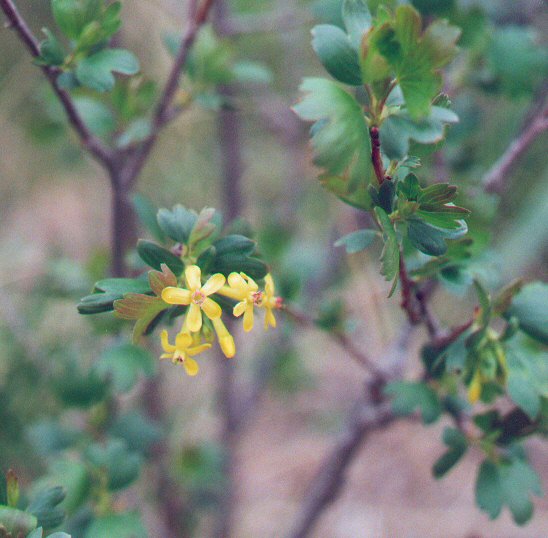Ribes odoratum H.L. Wendl.
Golden Currant

Native
CC = 10
CW = 5
MOC = 13
© SRTurner
Ribes odoratum H.L. Wendl.Golden Currant | |
 |
Native CC = 10 CW = 5 MOC = 13 |
© SRTurner |
|
Family - Grossulariaceae Habit - Shrub, to about 2 m high. Stems - Bark smooth to somewhat scaly, often peeling or shredding in narrow papery strips, gray to reddish brown.
Leaves - Alternate, often appearing fascicled at the tips of short shoots. Petioles 1.5-5.0 cm long, glabrous or with sparse minute nonglandular hairs and/or longer capitate-glandular hairs. Leaf blades 1-5 cm long, broadly triangular-ovate to nearly circular in outline, the lobes mostly sharply pointed at the tip, broadly narrowed to truncate at the base, the margins entire to coarsely and mostly simply toothed, the upper surface glabrous, the undersurface glabrous or occasionally sparsely and minutely nonglandular-hairy.
Inflorescence - Racemes with 3-10 flowers. Flower stalks 3-8 mm long, jointed toward the tip.
Flowers - Hypanthium narrowly cylindrical, the tubular portion above the ovary 12-16 mm long, bright yellow. Sepals 3-6 mm long, oblong-ovate, bright yellow, glabrous. Petals 2.0-3.5 mm long, yellow to bright red. Ovary glabrous.
Fruits - Smooth globose berries 7-9 mm long, globose, glabrous, without prickles, yellow to greenish yellow, becoming black at maturity. Flowering - April - May. Habitat - Ledges and tops of bluffs; also roadsides and railroads. Sometimes cultivated. Origin - Native to the U.S. Lookalikes - Could be mistaken for other species of Ribes when not flowering. Other info. - This species is uncommon in Missouri, begin found naturally in only a few counties in the western Ozarks. It is also cultivated, so plants may sometimes be found at old homesites. It is far more common to our west, and is common in nearly every state from the Plains westward. When in bloom it is impossible to miss, as the masses of bright yellow flowers are both showy and fragrant. The aroma is responsible for the specific epithet, and was described by Steyermark as resembling a combination of the spiciness of cloves and the sweet fragrance of carnations, especially in the afternoon. Photographs taken at the Kansas City Zoo, 6-29-99 (DETenaglia); also near Hyannis, Grant County, NE, 5-9-2025 (SRTurner). |